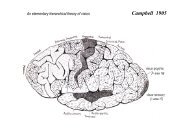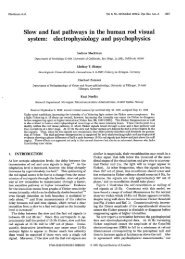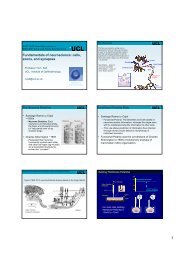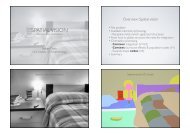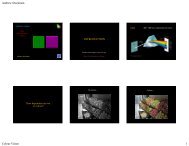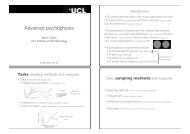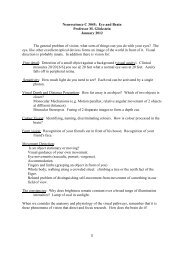Introduction to psychophysics
Introduction to psychophysics
Introduction to psychophysics
You also want an ePaper? Increase the reach of your titles
YUMPU automatically turns print PDFs into web optimized ePapers that Google loves.
<strong>Introduction</strong> <strong>to</strong> <strong>psychophysics</strong>Steven DakinUCL Institute of Ophthalmologys.dakin@ucl.ac.uk<strong>Introduction</strong>• To understand the brain, one must understand not onlyits components (e.g. physiology) and their purpose (e.g. via models)but also behaviour (e.g. <strong>psychophysics</strong>)• Psychophysics characterises the relationship betweenphysical (e.g. visual) stimuli & behaviour (e.g. of humans). Revealsmechanism (e.g. trichromacy), links <strong>to</strong> other disciplines (e.g. viastats), clinical applications (e.g. diagnosis), etc.• Psychophysical experiments involve• A stimulus/phenomenon (e.g. illusions) Hard• A task (e.g. matching)• A method (e.g. adjustment)• A performance-measure (e.g. threshold,PSE)Psychophysics/methodologyTasks, sampling methods and measures• Tasks (what does the subject do?)• Magnitude estimation (“how bright is it?”)Tasks, sampling methods and measures• Detection (“is it there?”); yes/no requires criterionSteven’sPower Law• Discrimination (“which is brighter”); forced choice is criterion-free• Sampling methods (how <strong>to</strong> select stimulus magnitude?)• Adjustment (under observer-control)• Method of constant stimuli (predefined set of stimulus magnitudes)• Method of limits (staircase; select stimulus based on previous responses)Weber-FechnerLaw
Tasks, sampling methods and measures• Measures: (how <strong>to</strong> characterise behaviour?)• Reaction times (how long <strong>to</strong> judge?). Atheoretical, but popular (e.g. IAT)• Stimulus(letter)Example I: Acuity• Task (letteridentification;10 alternatives)• Percent correct (what level of performance at a fixed stimulus magnitude?): e.g.observers memorise 10 objects & are presented with a new set containing 5 they saw and 5they hadn’t. Observer #1 recognises them all, observer #2 none; both score 50% correct...• Method (adjustment)• Point of subjective equality (stimulus mag. producing a perceptual match?)Appearance• Thresholds (minimum stimulus mag. producing some level of performance?).Absolute and relative...• Principled (signal detection theory). • Reliable/replicable• Efficient • VersatilePerformanceLetter sizeIssues:criterion,speed[1 2 3Trial #• Performancemeasure(average setting = sizethreshold)Example I: AcuityExample I: Acuity• Stimulus(letter)• Method (method of constant stimuli)Letter sizeCorrectIncorrect5 10 15 20Trial #Issues: efficiency/speed• Task(reading, 10AFC forced choice)TrialRun“B” ! “N” ! “O” " ...• Performance measure(acuity threshold)1.00.550.1PsychometricfunctionAcuity/sizethreshold[Acuity threshold:Size leading <strong>to</strong>79.2% correctidentification• Method (method of limits, adaptive, “3-down-1-up” staircase)Letter sizeIssues: efficient butdemanding(chart based)CorrectIncorrect5 10 15 20 25 30 35 40 45• Performancemeasure (threshold)Trial #Clinical visual acuity: 20/20means we can read letters20ft away, with line thicknessof 1.75mm (1 arc min.)
Prop. “1 brighter”Example II: Contrast detectionΔL{•• Task (detection)“Yes” ! “No” ! “No” "Stimulus (disc)C=ΔL/L back...• Method (method of constant stimuli)!16 trials !16 trials !16 trials ...LL back• Performance measure(absolute threshold)Prop. correct1.00.750.5PsychometricfunctionDetectionthreshold0.0 0.1 0.2ContrastPsychometric functions for detection and discriminationProportion correct0.75Stimulus contrast0.01.00.5 1.00.01.00.51.0BetterSlope∝Worse0.831/threshold0.5thresholdProportion “2 “higher” is 0.50.0Stimulus contrastPSEslope=thresholdthreshold• Two key psychophysical measures• Point of Subjective Equality (PSE) or bias measures appearance (accuracy)• Threshold (here, increment threshold) measures limits* of performance (precision)(*generally interested in best possible performance)(Accuracy versus precision: an accurate but imprecise clock, on average yields the right time, but individual readings vary wildly.An inaccurate but precise clock is e.g. reliably an hour slow)#1#2Shift=bias orappearance“Forced-choice” vs “Non-forced choice”• Experiment in which two or more alternatives arepresent (e.g. “which side is patch on?”, “which is bigger?”)• Some difference in convention as <strong>to</strong> whether bothalternatives must be present e.g. tilt. i.e. is itthe stimulus or the response?• If it’s response; detection is forced choice(actually 2AFC)“Criterion-free” vs “Criterion-dependent”• Yes/no means observer judges how strong stimulus mustbe <strong>to</strong> respond (“trigger happy”), forced choice does not• Different criteria bias subjects in detection. (Bias still arises indiscrimination but is less problematic since less meaningful “trade-off”...)Type 1 and Type II tasks• Type 1 tasks have a correct answer, Type II tasks do not. i.e. canwe provide feedback?1.00.50.02AFC Matching taskPhysicalmatchPoint of subjectiveequality (PSE)• Subtle: this experiment is about appearance (e.g. PSE, no feedback)• Appearance: “apparent magnitude”, performance: can be “better”• Above experiment measures both (slope/threshold & PSE/offset)...12
Signal detection theory (SDT; Green & Swets, 1966)• Trainee doc<strong>to</strong>rs ask “is a tumour present?” (“yes/no”, 50% present)• How do we assess performance?• Decisions limited by: information & criterionStimulusStimulusPresentAbsentResponse“Yes” “No” TotalHit, H (0.84) Miss (0.16) 1.0False alarm,FA (0.50)Correctreject (0.50)• ↑information high H, low FA (↑sensitivity)PresentAbsentResponse“Yes” “No” TotalHit, H (0.5) Miss (0.5) 1.0False alarm,FA (0.16)Correctreject (0.84)1.01.0• Doc<strong>to</strong>rs weigh errors differently• e.g. One considers missed diagnoses fatal,another minimises unnecessary procedures• Not information but bias/criterion that sets performanceNoise• Uncertainty on such tasks arises from two types of noiseIncreasing external noise →• External noise: measurements, variation in lung tissue• Assume doc<strong>to</strong>r uses neural responses <strong>to</strong> detect tumour,those responses are variable. This internal noise contributes<strong>to</strong> an internal responseCould be firing rate →noiseInternal-response probability ofoccurrence curves for noisealone & signal+noise trialsCriterion• Base response on some minimum/criterion responsed’=1.0• Effects of criterion shiftd’=1.0d’=1.0H=98%, FA=84% H=84%, FA=50% H=50%, FA=16%• Doc<strong>to</strong>rs cannot set their criterion <strong>to</strong> achieve only hits andno false alarms; noise overlap in prob. of occurrence curves internal responseon noise-alone must sometimes exceed signal+noise responseHit rate (H)1.0Betterdiscrim.Internal-response probability ofoccurrence curves for noisealone & signal+noise trialsReceiver operating curves & d’• Receiver operating curves (ROCs) plot a series of H/FAmeasurements; show choices made by doc<strong>to</strong>rd’=2d’=1d’=0.5d’=0random“Yes” Low0.5med.“No”highcriteriad’=z(H)-z(F)0.00.0 0.5 1.0False alarm rate rate (FA) (F)BiasNote upward bowingcurves (typically H>FA)• ↑ information (e.g. ↑signal) better separation• Reducing noise improves performance <strong>to</strong>o• Good measure of information content of internalrepresentation is: d’=separation/spread• ROC curves: practical & theoretical used’=1.0,lots of overlapd’=2.0less overlap



